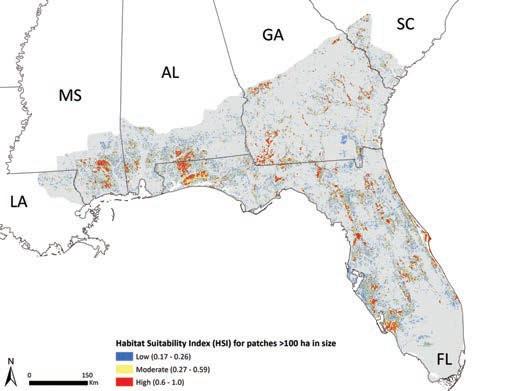
3 minute read
TECHNOLOGY CORNER
By Brian Crawford, PhD, Georgia Cooperative Fish & Wildlife Research Unit, University of Georgia
Providing Science for the Conservation of At-risk Reptiles & Amphibians in the Southeastern Longleaf Pine Ecosystem
Advertisement
The longleaf pine (Pinus palustris) ecosystem in the southeastern U.S. supports several “at-risk” species that are currently undergoing status reviews by the U.S. Fish and Wildlife Service (USFWS) to determine if they are threatened or endangered due to habitat loss and other threats. These include five reptile and amphibian (herpetofauna) species: the gopher tortoise (Gopherus polyphemus), gopher frog (Rana capito), striped newt (Notophthalmus perstriatus), southern hognose snake (Heterodon simus), and Florida pine snake (Pituophis melanoleucus mugitus). Conservation partners are grappling with tough decisions about how best to improve the statuses of these species before declines are irreversible, and there is currently limited scientific information on which to base those decisions. To address this need, a research team, headed by the USGS Georgia Cooperative Fish and Wildlife Research Unit at the University of Georgia, is developing models that predict the conditions of these species and
Distribution of suitable habitat (as of 2018), predicted by habitat suitability models, for the gopher tortoise, Gopherus polyphemus, across its range (grey shaded area) in the southeastern United States. This version of the map only shows patches of suitable habitat greater than 100 ha in size. Courtesy of Crawford, et al. 2020.
their habitats under current and future threats and management options. The project is taking advantage of knowledge and data on these herpetofauna from a large network of conservation partners across the Southeast, including many state and federal agencies, non-governmental organizations, academic institutions, and other partners who will use the models to make conservation decisions. These groups have actively contributed data to the project and participated in workshops to review and inform model development and outputs. Together, the project has gathered a comprehensive dataset of over 70,000 species location records, which were used along with input from over 30 experts to develop predicted habitat suitability maps across each species’ range. Habitat suitability data and maps are now publicly available on ScienceBase.
Habitat suitability maps will add to the toolset of conservation planning in the Southeast at both local and range-wide scales. The maps have already informed the USFWS Species Status Assessments (SSAs), which are used when making listing decisions for the gopher tortoise and southern hognose snake. They will likely inform additional SSAs in the future. Regardless of final listing decisions, partners could use habitat maps in conservation planning to: 1. Assess suitability at a local site known to be occupied by a species and tailor site-level management (e.g., increased use of prescribed fire),
2. Prioritize survey efforts in areas of high suitability without known or documented species records (e.g., on private lands), or 3. Use the distribution of areas suitable for one or more species on protected or unprotected lands to identify priority areas for management, land acquisitions, or other strategies.
In the next phase of research, habitat suitability maps will be used, along with expert opinion and additional species data, to predict species outcomes under different scenarios of future threats and management decisions. These results will inform
An active gopher tortoise burrow in suitable habitat - an open canopy, mixed longleaf forest that receives frequent fire. Photo by Brian Crawford, Georgia Cooperative Fish & Wildlife Research

Unit.
A southern hognose snake found in a longleaf pine forest in North Carolina. Photo by Jeff Beane, North Carolina Museum of Natural Sciences.
where and how to invest conservation resources in the longleaf system to protect and restore them on public and private lands.
Research publication: Brian A. Crawford, John C. Maerz, and Clinton T. Moore (2020). Expert-informed habitat suitability analysis for at-risk species assessment and conservation planning. Journal of Fish and Wildlife Management. In-Press.
Online data available at: www.sciencebase.gov/catalog/item/5d0d2d45e4b0941bde52a20d











